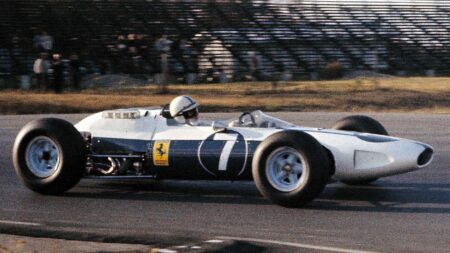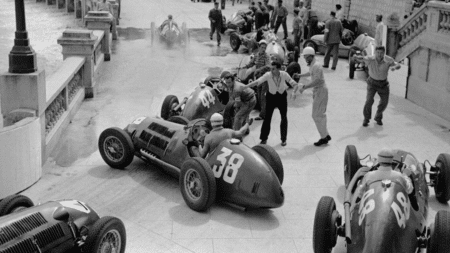Longridge: Lancashire’s muddy racing jewel, long forgotten
Perhaps there’s another similar venue obscured in the mists of time, but none springs to mind. Longridge was a circuit apart, crammed into the base of Tootle Heights – a disused quarry on the Lancashire moors, about eight miles north-east of Preston.

Measuring just 0.43 miles, it was licensed initially for just 10 cars (although that was later increased to 12, a cause for significant celebration). The layout? A couple of straights, one with a kink and the other preceded by a slight climb, plus two hairpins of slightly different ratio. The most recent programme I retain – from September 25, 1977 – proclaims that Warren Booth held the outright track record: the previous month, he’d managed a 23.2sec lap in the Patrick Head-designed Scott F2 car, an average speed of precisely 67mph.

Longridge first hosted car meetings in 1973, although sprints and kart races had been hosted previously while it had also served as a rally stage. Clubbies on two and four wheels were thereafter its staple, although it was as diverse as it was basic and there was a rallycross extension that took in part of the customarily mud-and-gravel paddock (and attracted a round of the British championship in 1976).

By the decade’s end, sadly, it was gone, the land sold to a firm that transformed it into what is nowadays the Beacon Fell View Holiday Park. Where once Kim Mather’s BRM P153 bestrode the land, there are now static caravans.

A few years ago I happened to be in the area and my inner homing pigeon led me straight to the main entrance, a small gap between dry-stone walls. I paused before proceeding, wondering whether it was best to preserve the images of my mind’s eye, but curiosity got the better of me. If you hadn’t been there in period you’d never imagine that racing could ever have taken place, but bits of the circuit were just about visible and the rocks that lined the old Quarry Straight looked exactly as they had more than 30 years previously. It’s just that they were now bordered by caravans, rather than a small mob of Formula Ford cars.

For a kid living near Altrincham, it sometimes felt frustrating that Brands Hatch and Silverstone hogged most of the nation’s major meetings during the 1970s… but compensation came in the form of easy access to Oulton Park, Aintree and Longridge.

Not too bad a place to grow up, then, but I wish they’d get rid of the bloody caravans and reinstate Longridge’s true purpose. It was a bewildering place in some ways, but blessed with a certain beauty.
Longridge is not the only now-defunct race facility in the United Kingdom. Motor Sport carried out a number of track tests on sadly departed – but not forgotten – circuits which you can read about in our archive. We’ve included excerpts below.
Aintree:
Taken from Motor Sport January 2001.
“Think Aintree – motor racing at Aintree – and if you’re like me, you will conjure up two streaks of silver flashing past the chequered flag, just two-tenths of a second apart. The white-helmeted figure in the lead raises a gloved hand in acknowledgement of his first win in the highest echelon of motorsport. “And Moss wins the British Grand Prix,” the plummy voice declares excitedly before adding, grudgingly, “albeit in a German car.” Patriotism, they called it. Ah, but Mercedes-Benz were wise to that, had learnt their lesson from Le Mans three years earlier, when a 1-2 for the silver cars had been greeted in silence by the French crowd. So Stirling’s W196 bore a Union Jack on its flank. And maybe as Moss himself has wondered since the victory, too, was a gift to a Briton in Britain. Whether it came from Alfred Neubauer or Juan Manuel Fangio, who knows? If there was a secret, the men involved took it to their graves.”
To read the rest of this article click here.
Crystal Palace:
Taken from Motor Sport November 2000.
“Whit Monday, 1964. Top deck of a Routemaster, the windows rattling in sympathy with its faithful Gardiner’s lumpy idle. Down those curving stain two at a time, one more bound and out the back. The bus hasn’t come to a dead stop and the conductor shouts something. What’s his problem? Hasn’t he heard the ‘Stones or the Beatles? Hey, I’m the future, mate. ‘The white heat of technology’ and all that Outta m’way, grandad.
“Dive across Anerley Road, through the traffic and turnstiles and across the footbridge from Low Level Station. The new National Sports Centre is down the hill to the right — hugging the inside of Ramp Bend, to be exact — but who cares? Athletics is way too slow. Some reckon the Centre’s arrival might affect the racing, though. Now that would be serious.”
To read the rest of this article click here.
Dundrod:
Taken from Motor Sport October 2000.
“Get it stopped. Stuff it in to the apex. Nail it on the way out. Medium-speed, high-downforce is the current Formula One way. Flat out is flat out is flat out — always has been, always will be. It’s the ‘float’ that’s almost sunk without trace; the ability of a Moss, Clark, or Schumacher (it still distinguishes the best from the rest) to pick up a car and skim it across the surface, shedding not a jot of speed, aiming not driving, visibly quicker. Flat in top is the catalyst That’s why we rave about Eau Rouge, Suzuka’s 130R, the opening sequence of Becketts, for such corners are few and far between these days.
“Not at Dundrod they’re not Beyond that ‘maybe flat’ sweeper lies another, and another, often as not just over a crest. Picture yourself in a D-type on rock-hard Dunlops, live rear axle shimmying from 130mph bump to 130mph bump, on a narrow, seven-mile circuit complete with its own microclimate (slap bang in a Belfast water catchment area) and the mere thought makes your throat parch, heart race, palms moisten.”
To read the rest of this article click here.
Rest and be thankful:
Taken from Motor Sport December 2003.
“Above us there’s a notch in the grey mountains, the crest of the pass. Groups of tourists are gazing down the valley, but few of them know what they’re looking at; it’s just a disused, crumbling road leading from the car park to nowhere much. No particular landmarks, no buildings to arouse curiosity. That’s if you’ve never seen the photographs. Images of Ken Wharton painting twin black take-off lines with his ERA. Of Dennis Poore sliding his grand prix Alfa Romeo through the hairpin. Of Tony Marsh aviating his 4WD Special. Put those in your mental album and suddenly this dank and derelict track regains its dignity. This used to be the nearest thing we had to a mountain hillclimb. It was a whole mile long to start with (cut to 1475yds latterly); well shy of the marathon continental slopes, but the only one which has a real Alpine flavour.
“For 200 years this pass has been a crucial route from Glasgow to the Western Highlands. It cuts across the neck of the Bute peninsula between the vertebrae of what the locals call the Arrochar Alps, scrambling out of Glen Croe and over a narrow saddle between the stony flanks of Ben Arthur — also called The Cobbler— and Ben Donich. It’s also a monument to military control.”
To read the rest of this article click here.











